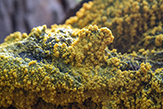Minnesota Slime Molds

Phylum Mycetozoa
Slime mold is a term of convenience grouping together several kinds of evolutionarily unrelated organisms.
Slime molds are characterized by the following:
- The cell walls contain cellulose, not chitin;
- They can live independently but can aggregate together to form multicellular reproductive structures;
- They have both a haploid phase, in which each cell nucleus contains one chromosome for each trait, and a diploid phase, in which each cell nucleus contains two chromosomes for each trait, all the chromosomes necessary for reproduction; and
- Their life cycle consists of a protozoa-like amoeba stage (plasmodium) and a fungus-like spore-producing stage.
Slime molds were formerly placed in the subkingdom Gymnomycota within the Fungi kingdom, because they produce structures containing spores (sporangia). The modern classification has them divided among several supergroups. In taxonomic terms, the group slime molds is polyphyletic.
The taxonomy of slime molds changes frequently—it is a work in progress. There is much disagreement about the taxonomy of slime molds above the rank of order. As understood by protistologists, who study slime molds among other things, slime molds are a diverse group of distantly related organisms in several unranked clades. Outside of the rarified domain of protistologists, most taxonomic sources place all slime molds in a single phylum, and most of those sources use the name Mycetozoa.
The ranking on MinnesotaSeasons.com follows Global Biodiversity Information Facility (GBIF), MycoBank, MycoPortal, Catalogue of Life (COL), and iNaturalist. It is not in agreement with Index Fungorum or ITIS.
Recent Additions

Plasmodial slime molds are single-celled organisms, masses of protoplasm without cell walls and with thousands of nuclei. Like animals, they move and violently eject unwanted inorganic materials. Like amoeba, they feed by engulfing particles of food. Like fungi, they reproduce by producing fruit bodies containing spores that are distributed by wind. Formerly classified as fungi, plasmodial slime molds are now known to be unrelated.
Dog vomit slime mold (Fuligo septica) is a plasmodial slime mold. It has a worldwide distribution, occurring on every continent except Greenland and Antarctica.
Dog vomit slime mold is often found in urban areas from May to October. It grows on the rotten wood of stumps, logs, and wood mulches; on garden soil enriched with manure; and also on living plants. It may migrate one meter or more to nearby food sources. It feeds on bacteria, spores of fungi and non-flowering plants, protozoa, and nonliving organic matter. Its common name accurately describes its appearance. It is not edible.
Dog vomit slime mold may appear as a cushion-like mass, a slimy sheet, or a crust-like sheet. When it first appears it is white to yellow and slimy. At some point it transforms into a large, cushion-like, white or yellowish fruiting body covered by a brittle crust. Breaking the crust away reveals a dull black spore mass.

Many-headed slime (Badhamia polycephala) is a plasmodial slime mold. It has been reported in Europe, Asia, Australia, Africa, North America, and South America. Most reports are from the eastern United States.
All but a few plasmodial slime molds are invisible to the naked eye, are usually overlooked, and are little studied.
Many-headed slime is an exception in all respects. It is most often found on a growth medium (agar) in laboratories, where it is frequently used in researching cell development, protoplasmic streaming, and nuclear behavior. In one interesting study it was “shown” that it “solved” a maze. In nature it is found on shaded rotting wood in forests, in woodlands, and even in treed suburbs. It is short lived, appearing after a soaking rain and disintegrating in just a few days.
Many-headed slime lives in rotting wood feeding on fungi and bacteria. In late summer and fall, after a soaking rain, it creeps to the surface of the substrate. It appears as a bright yellow, many-branched network of veins that creep along the surface. Protoplasm can be seen streaming within the veins. When exposed to light it produces spore-bearing structures (sporangia). The sporangia differ from other slime molds in having multiple heads, hence the common name many-headed slime.

Protostelid slime molds are relatively unknown and easily overlooked. They were first recognized in the early 1960s and have been little studied since. There are 36 currently accepted species, and possibly twice that number of undescribed species. Most are microscopic. Only a few are visible to the naked eye.
Honeycomb coral slime mold (Ceratiomyxa fruticulosa) is the most commonly encountered protostelid slime mold and may be the most common slime mold of any kind in the world.
It occurs on every continent except Greenland and Antarctica. It is found in forests on rotting fallen logs and branches. It can form extensive colonies one meter or more long. It is very short lived, appearing after a soaking rain and disintegrating in just a few days.
Honeycomb coral slime mold first appears as a thin, watery, translucent, mucus-like layer, creeping across the wood, engulfing bacteria, protozoa, and particles of nonliving organic matter. Eventually it fruits, forming clusters of erect, translucent columns. The columns have a frosted or powdery appearance due to a dense covering of tiny, white, spores on long, thread-like stalks.

Wasp nest slime mold (Metatrichia vesparium) is common and widespread. It is found in Europe, Asia, Africa, Australia, and North and South America. In the United States it is common east of the Great Plains, including Minnesota, less common in the west. It grows in open forests on dead and rotting wood, especially hardwood.
The fruiting body may be attached directly to the substrate or rise in a densely crowded group of up to twelve on a common stalk. The individual spore-producing structures are dark red or reddish-purple to nearly black, less than ⅛″ in height, and about 1 ⁄32″ in diameter.
They are mostly cone-shaped and have a convex, shiny, iridescent, lid on top. When mature, the lid swings open like a jack-in-the-box, and the red or rust-red interior expands outward. When this dries out, the spores are disbursed by wind. Eventually, the expanded portion disintegrates. What is left looks like the nest of a paper wasp, giving this slime mold its common name.

Slime mold is a term of convenience grouping together several kinds of unrelated organisms. They were formerly placed in the Fungi kingdom because they produce structures containing spores (sporangia). The modern classification has them divided among several supergroups. The taxonomy of slime molds changes frequently—it is a work in progress.
Red raspberry slime mold is one of the most commonly encountered slime molds in woodlands. It appears from June through November as a pink to bright red, pillow-shaped, tightly-packed mass on well-rotted logs, sometimes on moss. The surface is knobby, like a raspberry. It is not edible.
Other Recent Additions
This list includes only slime molds that have been recorded in Minnesota, but not all of the slime molds found in Minnesota.
| Profile | Photo | Video | |||
|---|---|---|---|---|---|
ashen slime mold (Physarum cinereum) |
|
||||
carnival candy slime mold (Arcyria denudata) |
|||||
Chinese lantern slime mold (Dictydium cancellatum) |
|||||
chocolate tube slime mold (Stemonitis axifera) |
|||||
coral slime mold (Ceratiomyxa porioides) |
|||||
dark-brown wood-hair (Stemonitis fusca) |
|||||
false puffball (Enteridium lycoperdon) |
|||||
insect egg slime mold (Leocarpus fragilis) |
|||||
plasmodial slime mold (Dictydium cancellatum) |
|||||
pretzel slime mold (Hemitrichula serpula) |
|||||
push pin slime mold (Hemitrichia calyculata) |
|||||
slime mold (Angioridium sinuosum) |
|||||
slime mold (Badhamia utricularis) |
|||||
slime mold (Cribraria intricata) |
|||||
slime mold (Dictydiaethalium plumbeum) |
|||||
slime mold (Lycogala flavofuscum) |
|||||
slime mold (Oligonema favogineum) |
|||||
slime mold (Physarella oblonga) |
|||||
slime mold (Stemonitopsis typhina) |
|||||
tapioca slime mold (Brefeldia maxima) |
|||||
white carnival candy slime mold (Arcyria cinerea) |
|||||
white-footed slime mold (Diachea leucopodia) |
|||||
yellow carnival candy slime mold (Arcyria obvelata) |
|||||
yellow-fuzz cone slime mold (Hemitrichia clavata) |
Angioridium sinuosum (slime mold)
Arcyria cinerea (white carnival candy slime mold)
Arcyria denudata (carnival candy slime mold)
Arcyria obvelata (yellow carnival candy slime mold)
Badhamia polycephala (many-headed slime)
Badhamia utricularis (slime mold)
Brefeldia maxima (tapioca slime mold)
Ceratiomyxa fruticulosa (honeycomb coral slime mold)
Ceratiomyxa porioides (coral slime mold)
Cribraria intricata (slime mold)
Diachea leucopodia (white-footed slime mold)
Dictydiaethalium plumbeum (slime mold)
Dictydium cancellatum (Chinese lantern slime mold)
Dictydium cancellatum (plasmodial slime mold)
Didymium spongiosum (dog sick slime mold)
Enteridium lycoperdon (false puffball)
Fuligo septica (dog vomit slime mold)
Hemitrichia calyculata (push pin slime mold)
Hemitrichia clavata (yellow-fuzz cone slime mold)
Hemitrichia decipiens (salmon-eggs)
Hemitrichula serpula (pretzel slime mold)
Leocarpus fragilis (insect egg slime mold)
Lycogala epidendrum (wolf’s milk slime mold)
Lycogala flavofuscum (slime mold)
Metatrichia vesparium (wasp nest slime mold)
Oligonema favogineum (slime mold)
Physarella oblonga (slime mold)
Physarum cinereum (ashen slime mold)
Stemonitis axifera (chocolate tube slime mold)
Stemonitis fusca (dark-brown wood-hair)
Stemonitis splendens (chocolate tube slime)
Stemonitopsis typhina (slime mold)
No Species Page Yet?
If you do not see a linked page for a species in the list at left you can still upload a photo or video or report a sighting for that species. Click on one of the buttons below and type in the common name and/or scientific name of the species in your photo, video, or sighting. A new page will be created for that species featuring your contribution.
These buttons not working for you?
Simply email us at info@MinnesotaSeasons.com.













